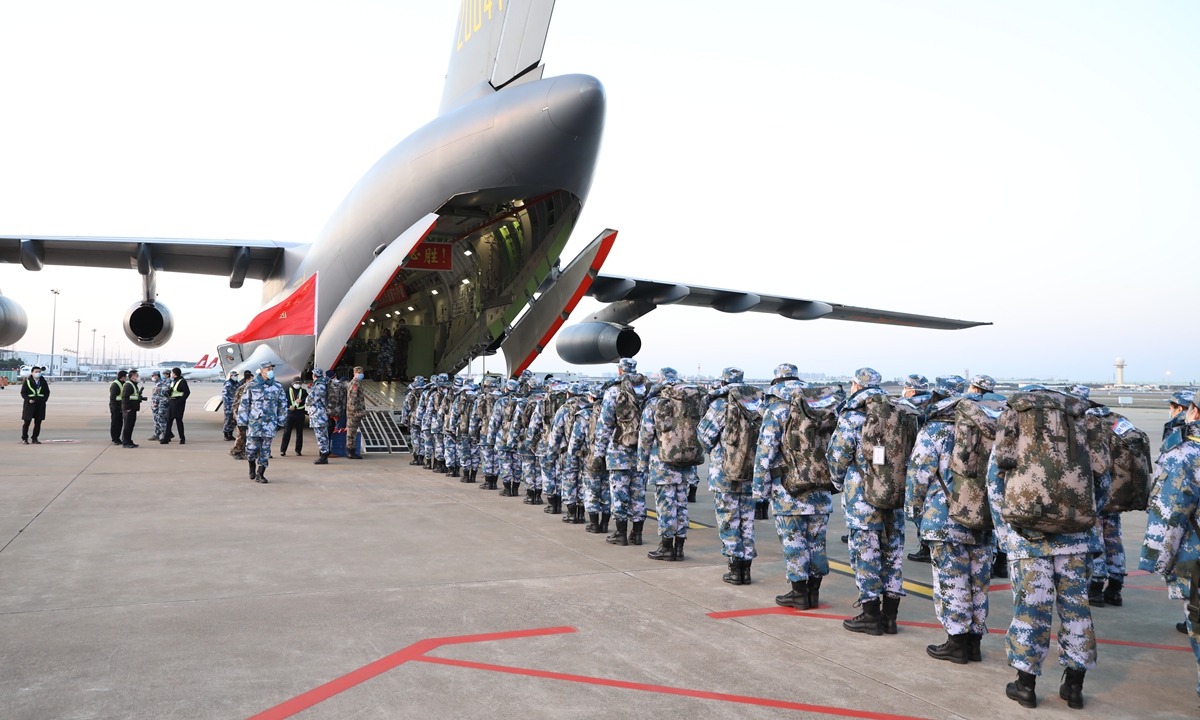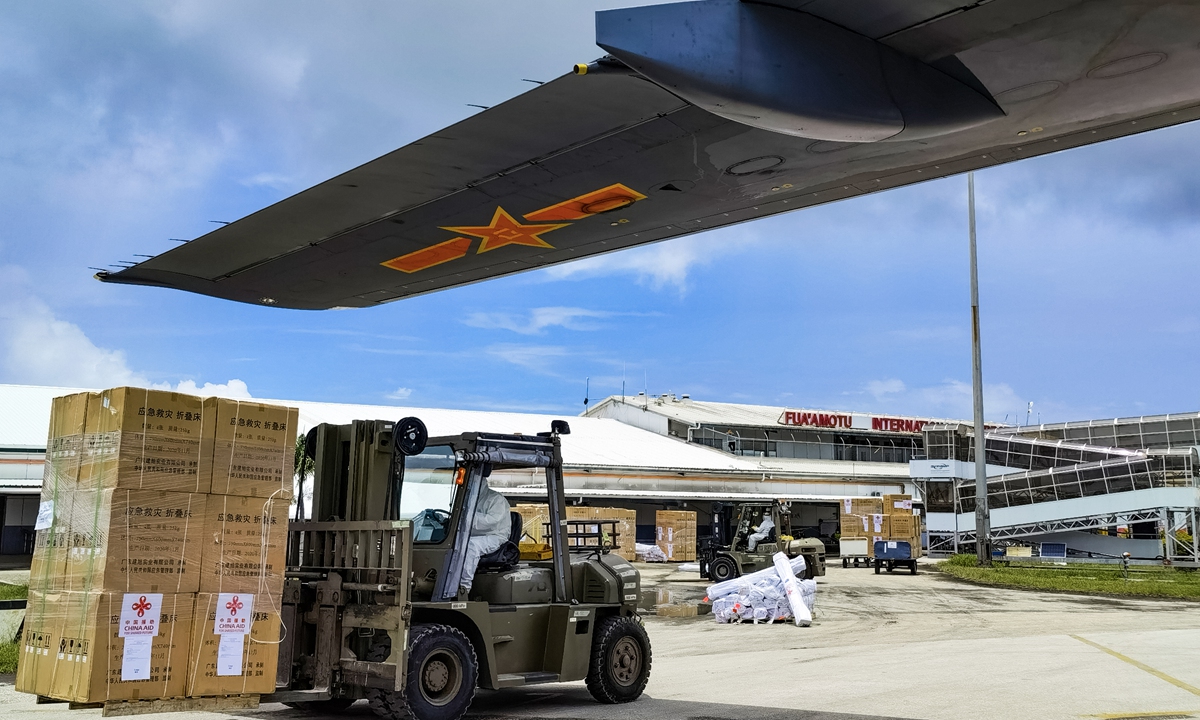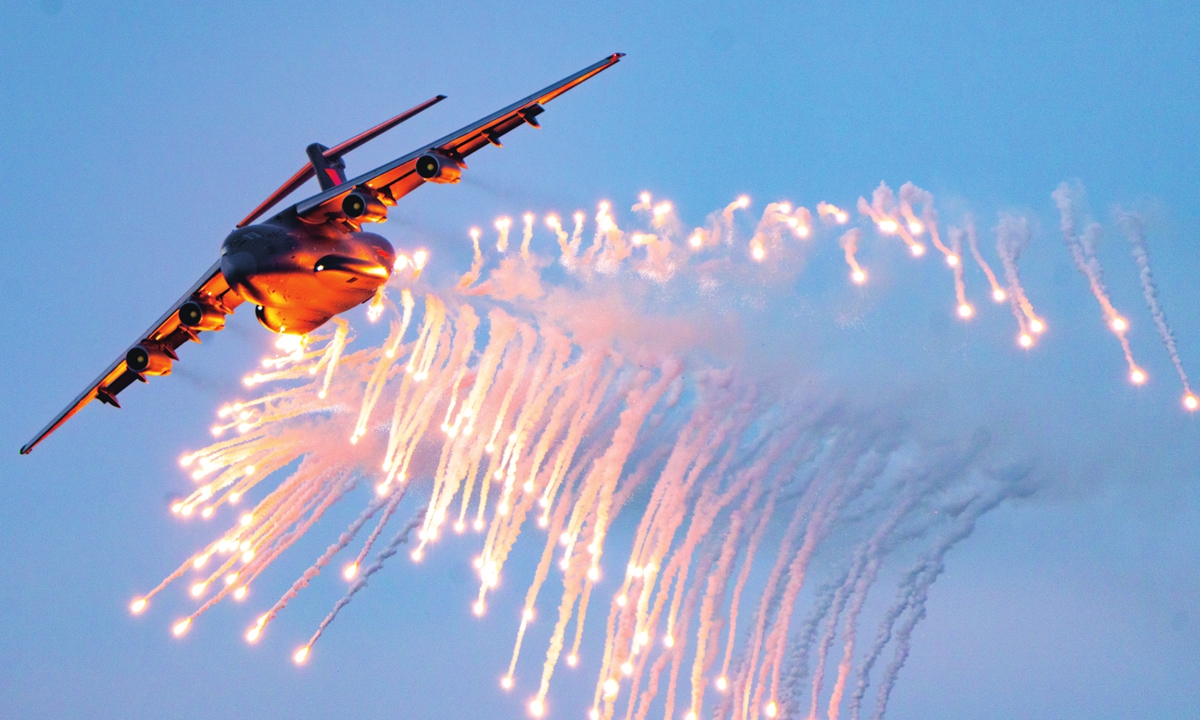
Members of the military medical team to assist Hubei board a Y-20 aircraft in Shanghai's Hongqiao International Airport on February 17, 2020. Photo: Long Deyong
In the honor room of a regiment attached to the Chinese People's Liberation Army (PLA) Central Theater Command Air Force, a trail map marked with red flags is particularly eye-catching: Tonga, Russia, South Korea... Those are cross-border air routes showing that the airmen of the regiment have piloted the large Y-20 transport aircraft throughout the world. These trails are a sign of the Air Force's hard work, and they also demonstrate China's active contribution to building a community with a shared future for mankind with practical actions. Pilots with the regiment told the Global Times in a recent interview that China's development means the growth of a force for world peace. For Y-20 pilots, the most exciting moment is the next flight mission, especially those to unfamiliar territories. When the task is completed, there is not only a sense of honor, but also the pride of having the support of a strong motherland.

Two Y-20 aircraft affiliated with a regiment attached to the PLA Central Theater Command Air Force arrive in Nuku'alofa, Tonga to deliver disaster relief supplies on January 28, 2022. Photo: Ding Zengyi
Y-20's epoch-defining significanceThe Y-20 is China's first large, independently developed, multi-purpose transport aircraft. It can perform long-distance air transport tasks of all kinds of goods and personnel under complex weather conditions.
In January 2013, Air Force test pilots successfully carried out the maiden flight of the Y-20. On July 6, 2016, the Y-20 was officially commissioned into the Air Force, marking a key step in the Air Force's strategic delivery capabilities.
Zhou Han, the leader of the Second Flight Detachment, likes this "flexible fat girl" very much. Whether it is takeoff, landing, subject training, or carrying out missions, the Y-20 gives him a feel of reliability. "The Y-20 subverts the design concept of traditional aircraft. The performance of the aircraft is closer to an actual combat model. It implements tactical maneuvers and completes tactical actions more smoothly on command."
"The most obvious and intuitive change of the Y-20 is that it is easier to operate. In the past, instruments on the operating panels of older transport aircraft were of the mechanical pointer-type. The pilots needed to dynamically monitor all kinds of data. Now, the Y-20 adopts a fly-by-wire operating system. It has greater advantages than previous aircraft in terms of aerodynamic design, combat effectiveness, and flight control." Zhou said.
Co-pilot Xia Xiong, who has a flight experience of 1,500 hours, has previously piloted different types of transport aircraft such as the Y-8. Xia said that, compared with previous aircraft he had piloted, the Y-20 marks a historic turning point. "The Y-20 is very intelligent and offers a very high degree of automation. From design to concept to the cockpit environment, it is at the world's top tier."
As the key equipment to realize the strategic transformation of the PLA Air Force and improve its strategic delivery capability, the commissioning of the Y-20 has set higher requirements for pilots. This means that the pilot must not only pilot the aircraft, but also comprehensively manage all of the plane's resources. "The Y-20 only has a crew of two compared with larger crews on older aircraft, which means that the pilots must undertake multiple roles such as piloting, navigating, and communication. This requires us to have a broader range of knowledge and thoroughly understand the aircraft's structure and how it works, and truly realize the integration of man and machine," Xia said.
Li Yan, the commander of the regiment, said that the deployment of the Y-20 has built an emotional bond between China and the people of the world, and has become a window through which the outside world can understand China and a calling card to showcase the image of the Chinese armed forces.
Ni Ming, the political commissar of the regiment, said that since the commissioning of the Y-20, the trails made by the aircraft have "covered more than 190 airfields, civilian or military, in 19 countries in Asia, Africa, Europe, and Oceania. The contrails of the Y-20 show China's duty of care as a major country."

A Y-20 aircraft affiliated with a regiment attached to the PLA Central Theater Command Air Force releases flares during a training exercise. Photo: Zhang Meng
One after another Strategic delivery capability is an important part of a country's rapid response capability and an important indicator of a country's national defense strength. Large military transport aircraft are the core pieces of equipment for realizing long-range and rapid strategic delivery of a military.
Since the Y-20 arrived in Wuhan, Central China's Hubei Province on February 13, 2020 transporting a military medical team and supplies to assist the province in fighting the COVID-19 outbreak, marking the aircraft's participation in a military operation other than war for the first time, the Y-20 has maintained a high workload, creating and breaking records one after another, as its strategic delivery capability has been fully tested.
On April 24, 2020, the Chinese military dispatched the Y-20 to provide emergency assistance to the armed forces of Pakistan with nucleic acid testing kits, personal protective suits, and other epidemic prevention and control supplies. This is the first time that the Y-20 has performed a mission abroad.
The first is just the beginning. Next, the Y-20 made frequent appearances on the world stage and became China's latest calling card highlighting the country's commitment to fulfilling its responsibilities and obligations as a major power.
According to publicly available reports, in just the first half of 2022, the Y-20 carried out numerous overseas missions. Especially in late January, a formation of Y-20s made a round-trip flight of 20,000 kilometers to Tonga to transport food, water purifiers, tents, and other relief supplies after the island country in the South Pacific was hit by an volcanic eruption and a subsequent tsunami. In mid-February, the Y-20 arrived in Honiara, the capital of the Solomon Islands, loaded with testing reagents, oxygen generators, and other anti-epidemic materials. The most recent trip was in late June, when several Y-20s arrived at Kabul Airport in Afghanistan with relief supplies including tents, towels, and foldable beds to assist the Afghan people after an earthquake.
To Zhou, going overseas to carry out transportation tasks is now routine, and each mission strengthens the pilot's technical ability and mental acuity. But for the aircraft, every overseas mission is a test, and the long-distance flight in unfamiliar airspaces and unexpected weather conditions can better test the equipment. "We completely trust our equipment, but we are also well prepared for all kinds of emergencies," Zhou said.
Consecutive missions have demonstrated the excellent performance of the Y-20. In late January this year, Zhou and his colleagues piloted two Y-20s during the Tonga mission. After a flight of more than 10,000 kilometers, they crossed the equator and arrived in Tonga, an island country in the South Pacific, to deliver humanitarian relief supplies. This is the Y-20's farthest delivery mission thus far.
Zhou said, "We did a lot of planning in advance. The climate in the Pacific Ocean is complex and dynamic, and we have made corresponding plans for various climatic conditions to accurately calculate the fuel consumption for long-term flights. At that time, there were aftershocks and sporadic volcanic eruptions in Tonga from time to time. The volcanic ash had a certain level of impact on the aircraft as well. We also prepared measures in case of an emergency."
Xia participated in the Pakistan mission for the first time to deliver anti-epidemic supplies. This was also his first overseas mission after switching to flying the Y-20. "Domestic and international media outlets have paid great attention to this mission." However, what impressed Xia was that compared with previous missions, he was not only a pilot, but also an English liaison officer, which was also a first. Xia and all other pilots had practiced their English intensively, which provides them with the fluency to communicate in the language while on overseas missions.
Challenges of overseas missionsZhou and Xia's experiences as well as those of their colleagues resonate with the public, but to them, these missions are nothing out of ordinary. Whether it is flying to Pakistan or Tonga, the flight skills required are the same with no deviations. Every overseas mission requires careful planning and overcoming of all kinds of challenges.
When receiving a mission to fly overseas, a lot of preparations must first be done, including the preparation of data related to the designated airport, the setting and planning of the flight routes, the prediction of the weather conditions during the flight, and setting of measures for various emergencies. A particularly special point of focus is the need for the pilot to understand the customs and religious beliefs of the destination country. Zhou said, "Our every move represents not only the image of the Chinese armed forces, but also China's national image. Therefore, we must start from the most minute of details, show good comportment, and convey the vision of peace."
Despite all the challenges, the pilots feel that all their hard work and collective efforts are worth it when they successfully deliver relief supplies to other countries. "When flying and touching down abroad the Y-20 with 'Chinese Air Force' painted on the fuselage in a foreign country and I see welcoming crowd with the Chinese flag fluttering in the wind, I am very satisfied, not only am I personally elated, but I also strongly realize that the motherland is our most powerful support," Zhou recalled.
Since 2020, air mechanic Kong Jianzhao and his colleagues have flown more than 30 sorties with the Y-20 to 10 overseas airports in 9 countries including Thailand, Sri Lanka, and Myanmar to deliver anti-epidemic materials, proactively contributing to global epidemic prevention and control. Kong was deeply impressed by many comments from foreign media outlets. "China's military might is not merely a show of force, but it is the capacity for helping the weak; not for war, but for peace." "China's development marks the growing force for world peace." "With China, we are not alone."






